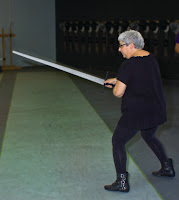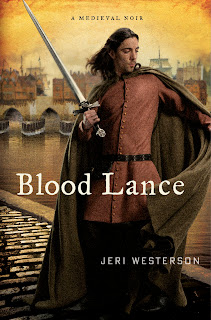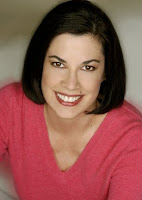Hi, it’s Linda here. Please welcome my friend and gifted writer of historical mysteries, Jeri Westerson. Jeri’s newest “medieval noir” Crispin Guest novel, Blood Lance, has just been published, and Jeri’s going to talk to us about the really extreme research she does in order to write about her disgraced medieval knight.
She’s Armed
By Jeri Westerson
When it comes to research, I’m a hands-on kind of gal. So
when I had an opportunity to put on some fourteenth century-style armor and get
a sword fighting lesson, I was all over it.
I have worn armor before, and have even sat on a
warhorse, a 2,000 pound Percheron while wearing light armor. My latest medieval
mystery BLOOD LANCE features a lot of sword craft and jousting, and in order to
give it the authenticity it needed, I’ve been venturing throughout southern
California eliciting the help of chivalrous knights far and wide. And no one
knows chivalry more than Scott Farrell.
I met Scott Farrell some years ago when we did a podcast
interview on his site Chivalry Today. But this hot August day, I met him in
person, along with his wife April, and Scott’s fellow instructor Kyle
Lazzarevich at Team Touche, a fencing club in San Diego, where they agreed to
fit me with armor so I can get the feel of it.
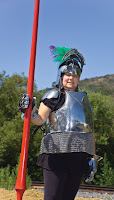 Scott is an historical sword fighting coach and an author
Scott is an historical sword fighting coach and an author
and historical interpreter on knights, medieval history, and chivalry.He got
interested in the Middle Ages in high school and later got the re-enactor bug,
and then started doing demonstrations for kids, which led him to think about connecting
the code of chivalry into everyday life and to his podcasts.
Medieval armor was crafted to fit the particular knight. You
didn’t just buy it off the rack at ye olde Walmart. So Scott had to cheat a bit
to fit it around my middle-aged frame and cheat some more to be able to
position the helm where I could half-way see. All in all, it’s unwieldy as you
can imagine, and heavy what with not being used to it and all. In reality, a
full set of armor or full harness weighs anywhere between 60 and 100 pounds,
but with the weight distributed all over the body it’s not as bad as it sounds.
Knights had to be able to move, fight, mount the horse, dismount. Though
because of the noise of mail and clanking plate, it wasn’t exactly build for
stealth. As a matter of fact, I’m betting that it was pretty intimidating hearing
that clanking sound approach and being confronted with a man in armor with a
sword, mace, flail, war hammer, ax, pole axe…well. You get the picture.
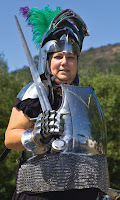
It was wonderful just closing my eyes and feeling the weight
of it, the smell, the sense of it on me, and imagining I am Crispin, my
medieval protagonist and detective, who lost his knighthood years before these
stories began.
Wearing armor is one thing—and a marvelous thing at
that!—but what was it like to fight with a sword?
In college I took fencing and was pretty darned good at it.
But fencing is a completely different style than medieval broad sword fighting.
Fencing is about style. Though it was utilitarian there was more in the way of
competition and style points than fighting and hacking away at an opponent. And
though medieval broad swords were also used in competition in tournaments, the
tournament was more for preparing for actual battle. Technique was important to
keep you alive, but it was more about what worked rather than panache. After
all, a broad sword is essentially a chopping and slashing weapon. It was your
shield in defense as much as it was used as an offensive weapon.
I learned about medieval weapons
through books and research. And I have my own cache of weapons I like to
demonstrate when I make appearances at libraries and bookstores. But there is
nothing like a hands-on approach. It’s not something that you can find readily
just anywhere.
Scott gave me a lesson in some medieval long sword
techniques. Keeping the blade edge toward your opponent and keeping it close to
your body were good tips. The use of the thumb on the leading hand on the hilt
can help balance but it is up to the student to decide to leave it vulnerable
above the cross guard. When using the sword two-handed, the leading hand
controls the vertical tilt of the sword, while the bottom hand controls the
horizontal. Flashy Hollywood-style fighting might look good on the screen, but
it leaves you wide open for a good gash to the torso. And who wants that?
After real training, could I take on an armored opponent?
Well, let’s just say, I’d rather leave the swordplay to experts, like Crispin.
Jeri Westerson wanted to create her
own brand of medieval mystery, and combined the concept of medieval mystery
with hard-boiled detective fiction into what she calls “Medieval Noir.”
Hard-boiled detective Crispin Guest, is a disgraced knight turned PI, solving
crimes on the mean streets of fourteenth century London. The critically
acclaimed series began with VEIL OF LIES, which garnered nominations
from the Mystery Reader’s Journal Macavity Award for Best Historical Mystery
and the Private Eye Writers of America Shamus Award for Best First PI Novel,
the first medieval mystery to be so honored. Each of the next three novels in the series garnered award nominations and critical praise, as well.
Publisher’s Weekly said of the fifth
in the series BLOOD LANCE; “Clever twists and convincing period detail make
Westerson’s fifth 14th-century historical featuring disgraced knight Crispin
Guest one of her best.” Kirkus Review said, “Guest’s fifth adventure
again provides a lively tale of historical interest smoothly combined with a
worthy mystery.” The Richmond Times-Dispatch said, “Written with a
keen knowledge of medieval history, ‘Blood Lance’ is another riveting tale of
honor and heroism, grounded in period detail, a wealth of action and the
continued development of her characters.” Jeri looks forward to the sixth, SHADOW
OF THE ALCHEMIST in the fall of 2013.
Jeri has done talks around the
country about the Middle Ages, demonstrating her cache of medieval weaponry.
She has been a featured guest on the radio talk show Writers on Writing with
host Barbara DeMarco-Barrett, and a guest lecturer at the Bowers Museum in
Santa Ana. Jeri is vice president for the
southern California chapter of Mystery Writers of America and is also vice
president of the Los Angeles chapter of Sisters in Crime, and co-chair for the
California Crime Writer’s Conference for June 2013. She is also a member of
Private Eye Writers of America and the Historical Novel Society. Jeri is
married to a commercial photographer, has a screenwriter son, and herds two
cats, a tortoise, and the occasional tarantula at her home in southern
California.




